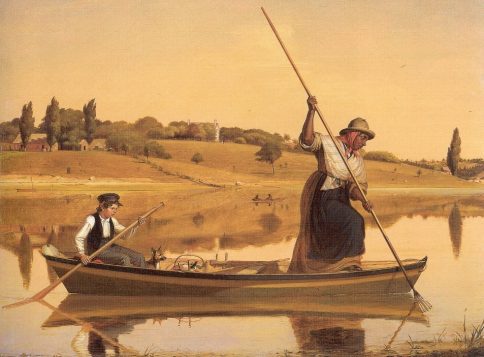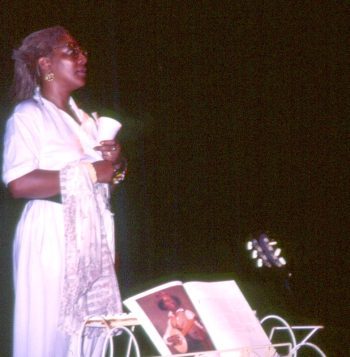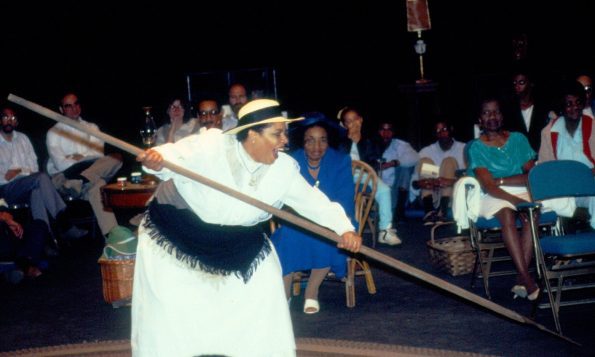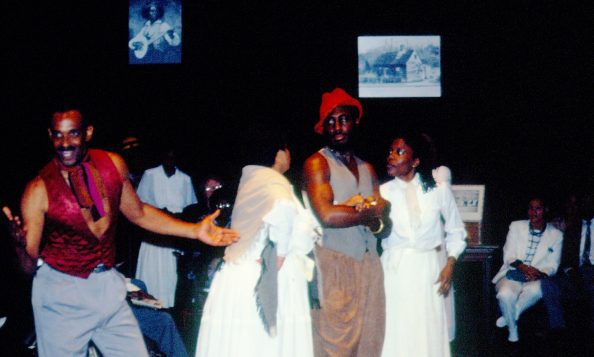By Beverly C. Tyler
In 1986, Glenda Dickerson, a theater arts professor at the State University of New York at Stony Brook, began an oral history project with her students, interviewing members of the African American Christian Avenue community. This resulted two years later in a four-day theater program which she described as a “living exhibit…a portrait of a community past and present.”
“When William Sidney Mount painted ‘Eel Spearing at Setauket (Fishing along Shore)’ in 1845 on contract for George Washington Strong he made, as far as we can tell, an exact representation of the landscape, but the people – painted later in his studio- are the past. The boy is thought to be William Sidney Mount himself and the woman, by tradition and folklore, is Rachel Holland Hart. They are perhaps a look back at an even earlier time when the 19th century was only in its infancy.” according to the exhibit and play “Eel Catching in Setauket” by Glenda Dickerson. It was Mount’s painting that inspired Dickerson to title her project “Eel Catching in Setauket.”
Before the theater experience, theater-goers were treated to a bus ride from the university to the African American Christian Avenue community, with a tour of the Bethel AME Church, graveyards and Legion Hall and then a meal shared with members of the community.
In the play, the actors portraying the members of the Christian Avenue community, the members themselves who contributed their oral histories, and the theater-goers, described by Dickerson as “eel catchers,” were together on the stage as joint parts of the play. Dickerson wrote in the souvenir journal and theater program, “An eel catcher is a person who loves people and old pictures and history and characters and folklore and drama and textures and art and fun and laughter and doesn’t mind experiencing them all at one time.”
Theodore Green, a descendant of Rachel Hart, was Glenda Dickerson’s guide and advisor, for the eel catching oral history project. In his story “The Hart-Sells Connection” in the Three Village Historical Society book “William Sidney Mount: Family, Friends, and Ideas”, Green wrote, “The woman is recognized to be Rachel Holland Hart, a housekeeper for Judge Selah Brewster Strong 3d…At the time the picture was painted, she was fifteen years of age…In planning the picture, Mount may have recalled scenes from his own childhood, when he was taught fish-spearing by an old Negro by the name of Hector.”
In the opening of the theater experience, Lynda Gravatt, portraying Rachel Holland Hart said the words Mount credits to Hector, “Slow now, we are coming on the ground. On sandy and gravelly bottoms are found the best fish. Look out for the eyes, there! Ha! Ha! He will grease my pan tonight.”
Seated behind Gravatt were the members of the Christian Avenue community. For the play, they took premier places on benches and pews in the Stony Brook University Art Center’s theatre as a dramatic feature of the presented living history.
As described by Dickerson, “The purpose of this living exhibit is to paint a portrait of a community, past and present. When you walk into the exhibit, it will be like walking into [the] souvenir journal. You will hear some of the same words. You will see the same photographs. You will see the stories leap to life as though from your own imagination.
“The photographs, the artifacts and the actors will tell stories that are sepia-toned, ebony, butterscotch and tea-rose, just like the women and men who shared their memories and their personal belongings with the project.
“The personal artifacts in the exhibit are not only displayed under glass to be contemplated in solitude and silence; they are living testaments to the warmth and generosity of Christian Avenuers. The prayer caps and church hats worn in the drama are not costumes, but actual items worn by the community. The pages of the souvenir journal, which document Bethel AME Church’s long and rich history will come to life as you read them. The eel spear Rachel Holland Hart carries is an authentic one.
“The magic circle of Christian Avenue – past and present – will stay with you. The trees have dappled the Avenue in the same way for a hundred years; the houses have held their secrets that long. Bethel’s bell has toiled seemingly forever. And the people have walked the Avenue from Setauket’s beginnings. Some of the folks lay in Laurel Hill, others in Bethel Cemetery; some have moved to far-flung places, others are still there. In my vision, they are one with the eelers and other workers who first came to Setauket, not voluntarily, and stayed to make history. In my vision, the autumnal elders will live forever, safe in the magic circle, shining like springtime. On Christian Avenue, it is forever Indian summer.”
Beverly C. Tyler is Three Village Historical Society historian and author of books available from the Three Village Historical Society, 93 North Country Rd., Setauket, NY 11733. Tel: 631-751-3730. WWW.TVHS.org










